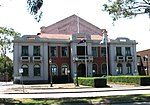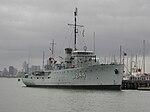Williamstown North, Victoria

Williamstown North is a suburb in Melbourne, Victoria, Australia, 11 km (6.8 mi) south-west of Melbourne's Central Business District, located within the City of Hobsons Bay local government area. Williamstown North recorded a population of 1,622 at the 2021 census.The suburb is bounded to the north by the Warrnambool railway line, to the west by the Altona branch of the Werribee railway line, to the east by Champion Road, and to the south by Kororoit Creek Road. Williamstown North is home to the Newport Railway Museum in Champion Road, on the south-east corner of the Newport Workshops. It is a short walk from the North Williamstown railway station. The Museum features the largest collection of Victorian Railways steam locomotives. Other exhibits include electric and diesel locomotives, suburban and country passenger carriages, guards vans, a selection of freight wagons and numerous railway artefacts.
Excerpt from the Wikipedia article Williamstown North, Victoria (License: CC BY-SA 3.0, Authors, Images).Williamstown North, Victoria
John Street, Melbourne Williamstown
Geographical coordinates (GPS) Address Nearby Places Show on map
Geographical coordinates (GPS)
| Latitude | Longitude |
|---|---|
| N -37.855 ° | E 144.89611111111 ° |
Address
John Street
John Street
3016 Melbourne, Williamstown
Victoria, Australia
Open on Google Maps










